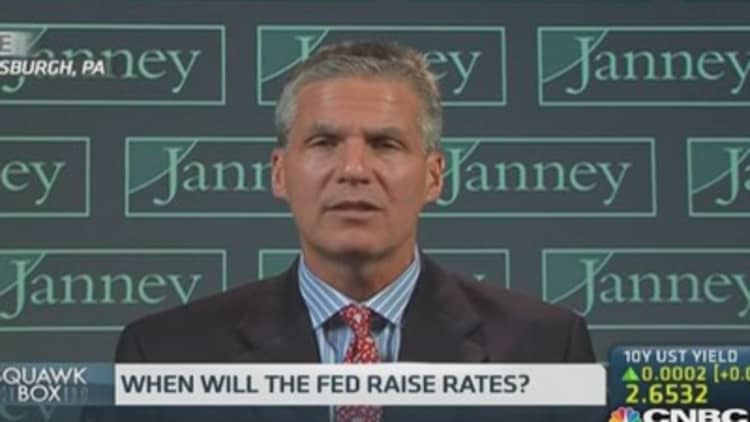
The biggest pickup in core consumer inflation in nearly three years makes the Fed's job tougher and adds fuel to market speculation that it will move faster to raise interest rates.
The consumer price index climbed 0.4 percent in May from a month earlier, higher than expected and the biggest increase since February 2013. The annual increase was 2.1 percent, following April's 2 percent year over year gain. Core CPI, excluding food and energy, was up 0.3 percent, the biggest increase since August 2011.
"It turns the heat up, and I think you'll hear the hawks turning up the volume, but I don't think the Fed in any way will respond to this," said Ward McCarthy, chief financial economist at Jefferies. "This will do two things. It will create a little more uncertainty about the Fed and create some volatility. Second, I think it will draw an even sharper distinction between the hawks and the doves, which will be a contributing factor to the increased uncertainty about the Fed."
Bond yields rose after the inflation number, as the Fed began its two-day meeting Tuesday. The CPI was boosted by a 0.9 percent jump in energy prices and a 0.5 percent for food, the fourth monthly increase and the biggest gain in three years. It was led by increases in meat, poultry and fish prices, up 1.4 percent. Shelter prices—for home rentals—increased by 0.3 percent.
Read More
The cost of cars, medical care and apparel also rose, but by far, the largest move higher was in airline fares, which jumped 5.8 percent, the biggest gain since 1999.
It is widely expected the Fed will announce that it will continue paring back its bond-buying program by another $10 billion; emphasize that it sees the economy improving but not enough; and stress that its actions are dependent on economic data.
"They're going to take down their growth forecast, and they're going to take down their unemployment forecast and they could raise the inflation forecast. That's a given," said Dan Greenhaus, chief global strategist at BTIG. "Some market participants are very fast to say: 'The Fed's going to tighten sooner.' .... It's been five years, and that camp has been wrong repeatedly."

But even if the Fed gives a nod to inflation, the CPI is not its choice metric. While CPI has climbed over the Fed's target of 2 percent inflation, the Fed watches the PCE, the personal consumption expenditures price index. That would be at an equivalent of just 1.5 percent, according to J.P. Morgan economists.
Fed officials are also expected to cut their forecast for GDP, after a negative reading on first quarter GDP. The central tendency in March was 2014 GDP of 2.8 to 3 percent. But at the same time, they should cut their views of the unemployment rate, which was forecast at 6.1 to 6.3 percent by the fourth quarter, since it is already at 6.3 percent.
Read MoreFed speak 3.0: The 'dot plot'
That has led to the speculation the Fed could also show that the views of some officials have changed on when it will raise the Fed funds rate for the first time. Those views are literally displayed as dots on a chart.
Currently, the market believes the first move will be later in 2015, but expectations could change to earlier in the year if individual officials change their forecasts, and that could create volatility.
"The dots will be moved. The real issue and the emphasis was on—and we started seeing [Fed Chair Janet] Yellen going on about—how long it will take for them to raise rates," said Diane Swonk, chief economist at Mesirow Financial. She said a 'normal' Fed funds rate would be 4 percent, but the Fed is now considering a new normal level at a lower rate.

Treasury yields rose Tuesday and stock gains were limited. The 10-year was yielding 2.644 percent, and the five-year note yield moved more dramatically to a high yield of 1.75 percent from an earlier level of 1.68 percent. The three-year rose out of its recent range, to 0.989 percent, a three-year high.
"The three-year Treasury notes are having a new high yield. They think the Fed is moving closer to tightening. If this meeting is status quo, yields are going to fall hard," said Chris Rupkey, chief financial economist at Bank of Tokyo Mitsubishi.
Rupkey said the economy is better than the Fed believes, and he hopes to see the central bankers move forward their views on when interest rates would be hiked.
Read MoreFed pouringfire on glowing embers of inflation: Grant
"I would think this could be a meeting where possibly the Fed chair gets some push back from the other members around the table. This will be one meeting where we see how effective she is in garnering votes and collecting the points," he said. "There's a lot of outlier opinions there. We'll see how all those opinions come together and make policy."
New members have joined the committee, including Stanley Fischer as governor, replacing Jeremy Stein, and Loretta Mester replacing Sandra Pianalto as president of the Cleveland Fed.
"If we don't get some big news tomorrow, the bond market is going to take the summer off," Rupkey said. "It's building for a crescendo here."
Read More
The Fed will also focus on the problems the economy faces.
"They have to deal with [the] housing market as one risk, plus the geopolitical risks and higher prices at the pump as a result of the geopolitical risks," said Swonk. Gasoline prices averaged $3.66 per gallon, up from the national average of $3.64 a week ago, and analysts see pump prices rising further based on the jump in oil prices on Iraq concerns.
Housing starts for May fell 6.5 percent by 1 million units, adding to concerns that the housing recovery has stalled.
—By CNBC's Patti Domm


